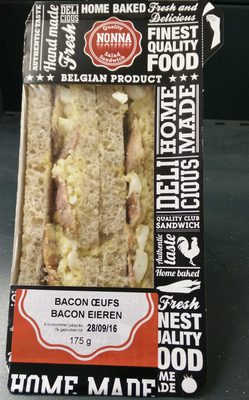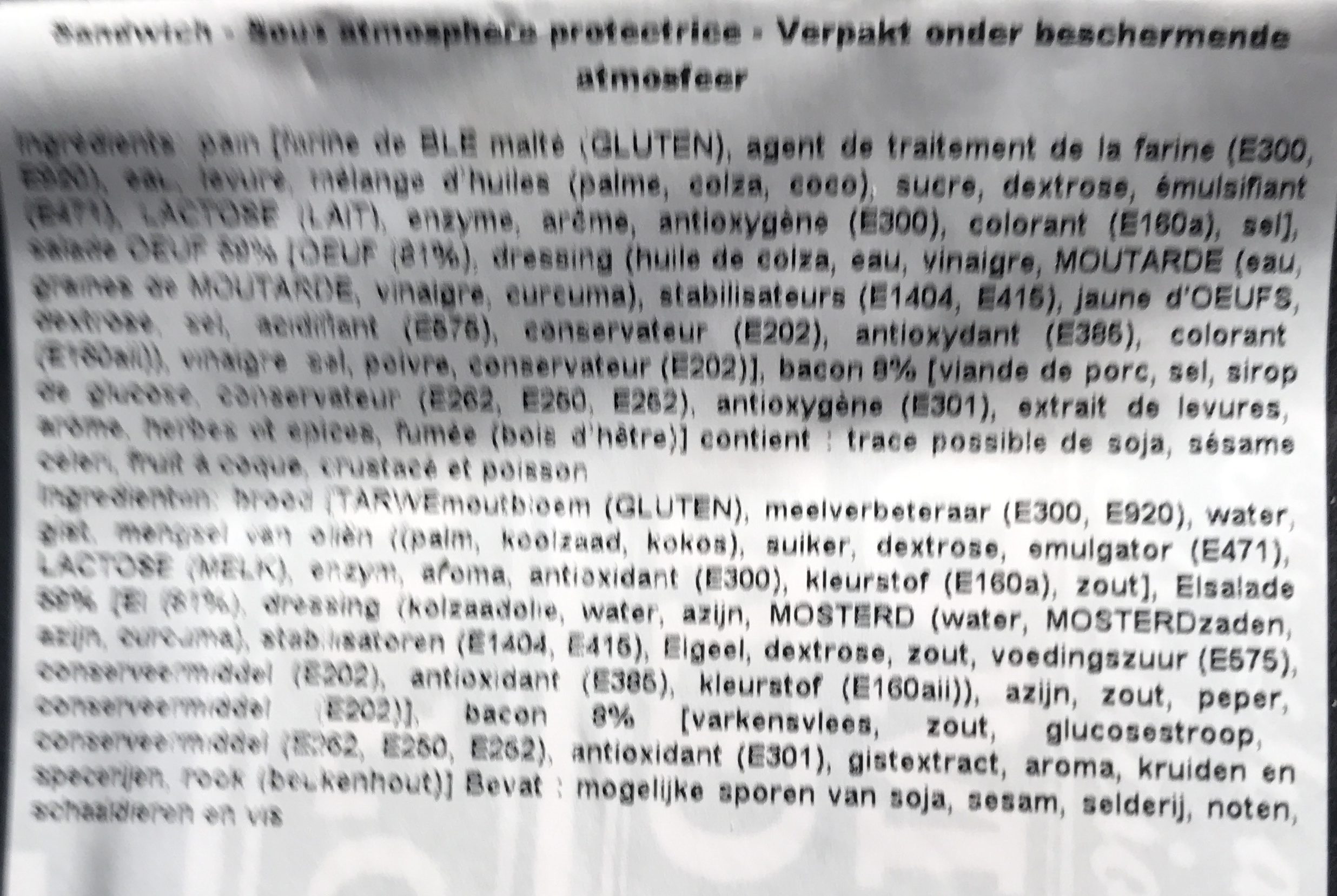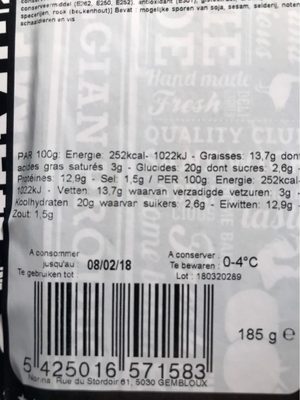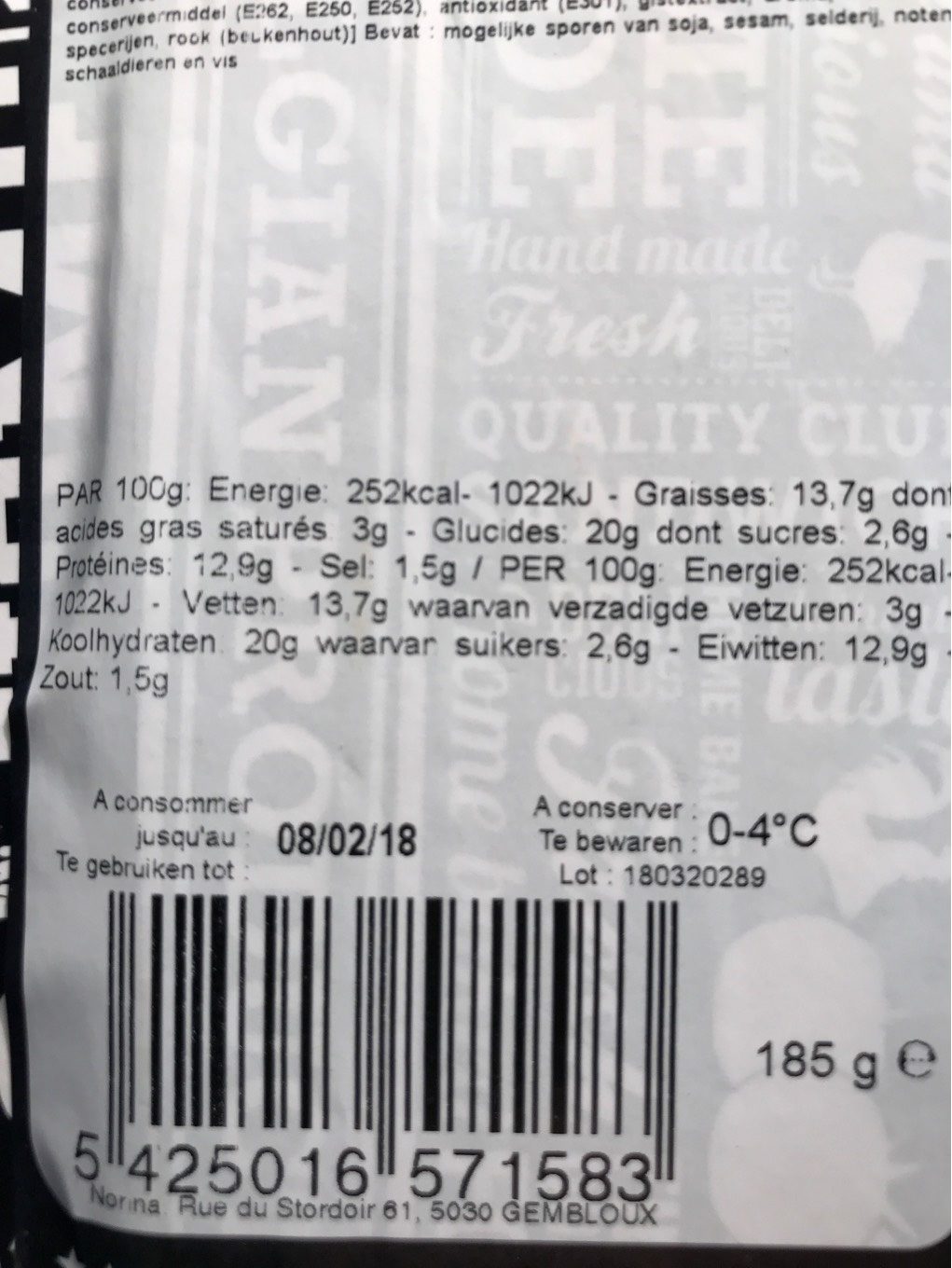Help us make food transparency the norm!
As a non-profit organization, we depend on your donations to continue informing consumers around the world about what they eat.
The food revolution starts with you!
Triangle Bacon Œufs - Trendy Food - 185 g e
Triangle Bacon Œufs - Trendy Food - 185 g e
This product page is not complete. You can help to complete it by editing it and adding more data from the photos we have, or by taking more photos using the app for Android or iPhone/iPad. Thank you!
×
Barcode: 5425016571583 (EAN / EAN-13)
Quantity: 185 g e
Brands: Trendy Food
Categories: Sandwiches, Sandwiches filled with cold cuts, Bacon sandwiches
Traceability code: BE 1112 EC
Matching with your preferences
Health
Ingredients
-
54 ingredients
Pain [farine de BLÉ malté (GLUTEN), agent de traitement de la farine (E300) eau, levure, mélange d'huiles (huile de palme, huile de colza, huile de coco), sucre dextrose emulsifiants E471), LACTOSE (LAIT), enzyme, arôme, antioxygène (E300), colorant (E160a), agent de traitement de la farine (E920), sel], salade d’œuf 44 % [ŒUF 79 %, mayonnaise (huile végétale (colza), eau, jaune d’œuf, vinaigre, MOUTARDE. sel, dextrose, stabilisateur (E466), conservateur (E202), arôme naturel), vinaigre, sel, conservateur (E202)]. lard fumé cuit 14 % [lard de porc fumé, sel, antioxydant (E301, E331), acidifiant (E326), conservateur (E250, E262), herbes)].Allergens: Gluten, Milk, OeufTraces: Celery, Fish, Soybeans
Food processing
-
Ultra processed foods
Elements that indicate the product is in the 4 - Ultra processed food and drink products group:
- Additive: E160a - Carotene
- Additive: E326 - Potassium lactate
- Additive: E466 - Sodium carboxy methyl cellulose
- Additive: E471 - Mono- and diglycerides of fatty acids
- Ingredient: Colour
- Ingredient: Dextrose
- Ingredient: Glucose
- Ingredient: Lactose
Food products are classified into 4 groups according to their degree of processing:
- Unprocessed or minimally processed foods
- Processed culinary ingredients
- Processed foods
- Ultra processed foods
The determination of the group is based on the category of the product and on the ingredients it contains.
Additives
-
E160a - Carotene
Carotene: The term carotene -also carotin, from the Latin carota, "carrot"- is used for many related unsaturated hydrocarbon substances having the formula C40Hx, which are synthesized by plants but in general cannot be made by animals -with the exception of some aphids and spider mites which acquired the synthesizing genes from fungi-. Carotenes are photosynthetic pigments important for photosynthesis. Carotenes contain no oxygen atoms. They absorb ultraviolet, violet, and blue light and scatter orange or red light, and -in low concentrations- yellow light. Carotenes are responsible for the orange colour of the carrot, for which this class of chemicals is named, and for the colours of many other fruits, vegetables and fungi -for example, sweet potatoes, chanterelle and orange cantaloupe melon-. Carotenes are also responsible for the orange -but not all of the yellow- colours in dry foliage. They also -in lower concentrations- impart the yellow coloration to milk-fat and butter. Omnivorous animal species which are relatively poor converters of coloured dietary carotenoids to colourless retinoids have yellowed-coloured body fat, as a result of the carotenoid retention from the vegetable portion of their diet. The typical yellow-coloured fat of humans and chickens is a result of fat storage of carotenes from their diets. Carotenes contribute to photosynthesis by transmitting the light energy they absorb to chlorophyll. They also protect plant tissues by helping to absorb the energy from singlet oxygen, an excited form of the oxygen molecule O2 which is formed during photosynthesis. β-Carotene is composed of two retinyl groups, and is broken down in the mucosa of the human small intestine by β-carotene 15‚15'-monooxygenase to retinal, a form of vitamin A. β-Carotene can be stored in the liver and body fat and converted to retinal as needed, thus making it a form of vitamin A for humans and some other mammals. The carotenes α-carotene and γ-carotene, due to their single retinyl group -β-ionone ring-, also have some vitamin A activity -though less than β-carotene-, as does the xanthophyll carotenoid β-cryptoxanthin. All other carotenoids, including lycopene, have no beta-ring and thus no vitamin A activity -although they may have antioxidant activity and thus biological activity in other ways-. Animal species differ greatly in their ability to convert retinyl -beta-ionone- containing carotenoids to retinals. Carnivores in general are poor converters of dietary ionone-containing carotenoids. Pure carnivores such as ferrets lack β-carotene 15‚15'-monooxygenase and cannot convert any carotenoids to retinals at all -resulting in carotenes not being a form of vitamin A for this species-; while cats can convert a trace of β-carotene to retinol, although the amount is totally insufficient for meeting their daily retinol needs.Source: Wikipedia
-
E202 - Potassium sorbate
Potassium sorbate (E202) is a synthetic food preservative commonly used to extend the shelf life of various food products.
It works by inhibiting the growth of molds, yeast, and some bacteria, preventing spoilage. When added to foods, it helps maintain their freshness and quality.
Some studies have shown that when combined with nitrites, potassium sorbate have genotoxic activity in vitro. However, potassium sorbate is generally recognized as safe (GRAS) by regulatory authorities.
-
E250 - Sodium nitrite
Sodium nitrite: Sodium nitrite is the inorganic compound with the chemical formula NaNO2. It is a white to slightly yellowish crystalline powder that is very soluble in water and is hygroscopic. It is a useful precursor to a variety of organic compounds, such as pharmaceuticals, dyes, and pesticides, but it is probably best known as a food additive to prevent botulism. It is on the World Health Organization's List of Essential Medicines, the most important medications needed in a basic health system.Nitrate or nitrite -ingested- under conditions that result in endogenous nitrosation has been classified as "probably carcinogenic to humans" by International Agency for Research on Cancer -IARC-.Source: Wikipedia
-
E262 - Sodium acetates
Sodium acetate: Sodium acetate, CH3COONa, also abbreviated NaOAc, is the sodium salt of acetic acid. This colorless deliquescent salt has a wide range of uses.Source: Wikipedia
-
E301 - Sodium ascorbate
Sodium ascorbate: Sodium ascorbate is one of a number of mineral salts of ascorbic acid -vitamin C-. The molecular formula of this chemical compound is C6H7NaO6. As the sodium salt of ascorbic acid, it is known as a mineral ascorbate. It has not been demonstrated to be more bioavailable than any other form of vitamin C supplement.Sodium ascorbate normally provides 131 mg of sodium per 1‚000 mg of ascorbic acid -1‚000 mg of sodium ascorbate contains 889 mg of ascorbic acid and 111 mg of sodium-. As a food additive, it has the E number E301 and is used as an antioxidant and an acidity regulator. It is approved for use as a food additive in the EU, USA, and Australia and New Zealand.In in vitro studies, sodium ascorbate has been found to produce cytotoxic effects in various malignant cell lines, which include melanoma cells that are particularly susceptible.Source: Wikipedia
-
E326 - Potassium lactate
Potassium lactate: Potassium lactate is a compound with formula KC3H5O3, or H3C-CHOH-COOK. It is the potassium salt of lactic acid. It is produced by neutralizing lactic acid which is fermented from a sugar source. It has E number "E326". Potassium lactate is a liquid product that is usually 60% solids but is available at up to 78% solids.Potassium lactate is commonly used in meat and poultry products to extend shelf life and increase food safety as it has a broad antimicrobial action and is effective at inhibiting most spoilage and pathogenic bacteria. Potassium lactate is also used as an extinguishing medium in the First Alert Tundra fire extinguishers.Source: Wikipedia
-
E331 - Sodium citrates
Sodium citrate: Sodium citrate may refer to any of the sodium salts of citrate -though most commonly the third-: Monosodium citrate Disodium citrate Trisodium citrateThe three forms of the salt are collectively known by the E number E331. Sodium citrates are used as acidity regulators in food and drinks, and also as emulsifiers for oils. They enable cheeses to melt without becoming greasy.Source: Wikipedia
-
E466 - Sodium carboxy methyl cellulose
Carboxymethyl cellulose: Carboxymethyl cellulose -CMC- or cellulose gum or tylose powder is a cellulose derivative with carboxymethyl groups --CH2-COOH- bound to some of the hydroxyl groups of the glucopyranose monomers that make up the cellulose backbone. It is often used as its sodium salt, sodium carboxymethyl cellulose.Source: Wikipedia
-
E471 - Mono- and diglycerides of fatty acids
Mono- and diglycerides of fatty acids (E471), are food additives commonly used as emulsifiers in various processed foods.
These compounds consist of glycerol molecules linked to one or two fatty acid chains, which help stabilize and blend water and oil-based ingredients. E471 enhances the texture and shelf life of products like margarine, baked goods, and ice cream, ensuring a smooth and consistent texture.
It is generally considered safe for consumption within established regulatory limits.
-
E920 - L-cysteine
Cysteine: Cysteine -symbol Cys or C; - is a semi-essential proteinogenic amino acid with the formula HO2CCH-NH2-CH2SH. The thiol side chain in cysteine often participates in enzymatic reactions, as a nucleophile. The thiol is susceptible to oxidation to give the disulfide derivative cystine, which serves an important structural role in many proteins. When used as a food additive, it has the E number E920. It is encoded by the codons UGU and UGC. Cysteine has the same structure as serine, but with one of its oxygen atoms replaced by sulfur; replacing it with selenium gives selenocysteine. -Like other natural proteinogenic amino acids cysteine has -L- chirality in the older D/L notation based on homology to D and L glyceraldehyde. In the newer R/S system of designating chirality, based on the atomic numbers of atoms near the asymmetric carbon, cysteine -and selenocysteine- have R chirality, because of the presence of sulfur -resp. selenium- as a second neighbor to the asymmetric carbon. The remaining chiral amino acids, having lighter atoms in that position, have S chirality.-Source: Wikipedia
Ingredients analysis
-
May contain palm oil
Ingredients that may contain palm oil: E160a
-
Non-vegan
Non-vegan ingredients: LactoseSome ingredients could not be recognized.
We need your help!
You can help us recognize more ingredients and better analyze the list of ingredients for this product and others:
- Edit this product page to correct spelling mistakes in the ingredients list, and/or to remove ingredients in other languages and sentences that are not related to the ingredients.
- Add new entries, synonyms or translations to our multilingual lists of ingredients, ingredient processing methods, and labels.
If you would like to help, join the #ingredients channel on our Slack discussion space and/or learn about ingredients analysis on our wiki. Thank you!
-
Vegetarian status unknown
Unrecognized ingredients: Pain, Farine-de-ble-malte, Agent-de-traitement-de-la-farine, Eau, Levure, Melange-d-huiles, Huile-de-palme, Huile-de-colza, Huile-de-coco, Sucre-dextrose-emulsifiants-e471, Lait, Arome, Antioxygene, Agent-de-traitement-de-la-farine, Sel, Salade-d-oeuf, Oeuf, Huile-vegetale, Colza, Eau, Jaune-d-oeuf, Vinaigre, Moutarde, Sel, Stabilisateur, Conservateur, Arome-naturel, Vinaigre, Sel, Conservateur, Lard-fume-cuit, Lard-de-porc-fume, Sel, Antioxydant, Acidifiant, Conservateur, HerbesSome ingredients could not be recognized.
We need your help!
You can help us recognize more ingredients and better analyze the list of ingredients for this product and others:
- Edit this product page to correct spelling mistakes in the ingredients list, and/or to remove ingredients in other languages and sentences that are not related to the ingredients.
- Add new entries, synonyms or translations to our multilingual lists of ingredients, ingredient processing methods, and labels.
If you would like to help, join the #ingredients channel on our Slack discussion space and/or learn about ingredients analysis on our wiki. Thank you!
-
Details of the analysis of the ingredients
We need your help!
Some ingredients could not be recognized.
We need your help!
You can help us recognize more ingredients and better analyze the list of ingredients for this product and others:
- Edit this product page to correct spelling mistakes in the ingredients list, and/or to remove ingredients in other languages and sentences that are not related to the ingredients.
- Add new entries, synonyms or translations to our multilingual lists of ingredients, ingredient processing methods, and labels.
If you would like to help, join the #ingredients channel on our Slack discussion space and/or learn about ingredients analysis on our wiki. Thank you!
: Pain (farine de BLÉ malté, agent de traitement de la farine (e300), eau, levure, mélange d'huiles (huile de palme, huile de colza, huile de coco), sucre dextrose emulsifiants e471, LACTOSE (LAIT), enzyme, arôme, antioxygène (e300), colorant (e160a), agent de traitement de la farine (e920), sel), salade d'_œuf_ 44% (ŒUF 79%, mayonnaise (huile végétale (colza), eau, jaune d'_œuf_, vinaigre, MOUTARDE, sel, dextrose, stabilisateur (e466), conservateur (e202), arôme naturel), vinaigre, sel, conservateur (e202)), lard fumé cuit 14% (lard de porc fumé, sel, antioxydant (e301, e331), acidifiant (e326), conservateur (e250, e262), herbes)- Pain -> en:pain
- farine de BLÉ malté -> en:farine-de-ble-malte
- agent de traitement de la farine -> en:agent-de-traitement-de-la-farine
- e300 -> en:e300 - vegan: yes - vegetarian: yes
- eau -> en:eau
- levure -> en:levure
- mélange d'huiles -> en:melange-d-huiles
- huile de palme -> en:huile-de-palme
- huile de colza -> en:huile-de-colza
- huile de coco -> en:huile-de-coco
- sucre dextrose emulsifiants e471 -> en:sucre-dextrose-emulsifiants-e471
- LACTOSE -> en:lactose - vegan: no - vegetarian: yes
- LAIT -> en:lait
- enzyme -> en:enzyme - vegan: maybe - vegetarian: maybe
- arôme -> en:arome
- antioxygène -> en:antioxygene
- e300 -> en:e300 - vegan: yes - vegetarian: yes
- colorant -> en:colour
- e160a -> en:e160a - vegan: maybe - vegetarian: maybe - from_palm_oil: maybe
- agent de traitement de la farine -> en:agent-de-traitement-de-la-farine
- e920 -> en:e920 - vegan: maybe - vegetarian: maybe
- sel -> en:sel
- salade d'_œuf_ -> en:salade-d-oeuf - percent: 44
- ŒUF -> en:oeuf - percent: 79
- mayonnaise -> en:mayonnaise - vegan: maybe - vegetarian: maybe - ciqual_food_code: 11054
- huile végétale -> en:huile-vegetale
- colza -> en:colza
- eau -> en:eau
- jaune d'_œuf_ -> en:jaune-d-oeuf
- vinaigre -> en:vinaigre
- MOUTARDE -> en:moutarde
- sel -> en:sel
- dextrose -> en:dextrose - vegan: yes - vegetarian: yes - ciqual_proxy_food_code: 31016
- stabilisateur -> en:stabilisateur
- e466 -> en:e466 - vegan: yes - vegetarian: yes
- conservateur -> en:conservateur
- e202 -> en:e202 - vegan: yes - vegetarian: yes
- arôme naturel -> en:arome-naturel
- huile végétale -> en:huile-vegetale
- vinaigre -> en:vinaigre
- sel -> en:sel
- conservateur -> en:conservateur
- e202 -> en:e202 - vegan: yes - vegetarian: yes
- lard fumé cuit -> en:lard-fume-cuit - percent: 14
- lard de porc fumé -> en:lard-de-porc-fume
- sel -> en:sel
- antioxydant -> en:antioxydant
- e301 -> en:e301 - vegan: yes - vegetarian: yes
- e331 -> en:e331 - vegan: yes - vegetarian: yes
- acidifiant -> en:acidifiant
- e326 -> en:e326 - vegan: yes - vegetarian: yes
- conservateur -> en:conservateur
- e250 -> en:e250 - vegan: yes - vegetarian: yes
- e262 -> en:e262 - vegan: yes - vegetarian: yes
- herbes -> en:herbes
Nutrition
-
Poor nutritional quality
⚠ ️Warning: the amount of fiber is not specified, their possible positive contribution to the grade could not be taken into account.⚠ ️Warning: the amount of fruits, vegetables and nuts is not specified on the label, it was estimated from the list of ingredients: 0This product is not considered a beverage for the calculation of the Nutri-Score.
Positive points: 0
- Proteins: 5 / 5 (value: 12.8, rounded value: 12.8)
- Fiber: 0 / 5 (value: 0, rounded value: 0)
- Fruits, vegetables, nuts, and colza/walnut/olive oils: 0 / 5 (value: 0, rounded value: 0)
Negative points: 11
- Energy: 3 / 10 (value: 1046, rounded value: 1046)
- Sugars: 0 / 10 (value: 2.8, rounded value: 2.8)
- Saturated fat: 2 / 10 (value: 3, rounded value: 3)
- Sodium: 6 / 10 (value: 600, rounded value: 600)
The points for proteins are not counted because the negative points are greater or equal to 11.
Nutritional score: (11 - 0)
Nutri-Score:
-
Nutrient levels
-
Fat in moderate quantity (13.7%)
What you need to know- A high consumption of fat, especially saturated fats, can raise cholesterol, which increases the risk of heart diseases.
Recommendation: Limit the consumption of fat and saturated fat- Choose products with lower fat and saturated fat content.
-
Saturated fat in moderate quantity (3%)
What you need to know- A high consumption of fat, especially saturated fats, can raise cholesterol, which increases the risk of heart diseases.
Recommendation: Limit the consumption of fat and saturated fat- Choose products with lower fat and saturated fat content.
-
Sugars in low quantity (2.8%)
What you need to know- A high consumption of sugar can cause weight gain and tooth decay. It also augments the risk of type 2 diabetes and cardio-vascular diseases.
Recommendation: Limit the consumption of sugar and sugary drinks- Sugary drinks (such as sodas, fruit beverages, and fruit juices and nectars) should be limited as much as possible (no more than 1 glass a day).
- Choose products with lower sugar content and reduce the consumption of products with added sugars.
-
Salt in moderate quantity (1.5%)
What you need to know- A high consumption of salt (or sodium) can cause raised blood pressure, which can increase the risk of heart disease and stroke.
- Many people who have high blood pressure do not know it, as there are often no symptoms.
- Most people consume too much salt (on average 9 to 12 grams per day), around twice the recommended maximum level of intake.
Recommendation: Limit the consumption of salt and salted food- Reduce the quantity of salt used when cooking, and don't salt again at the table.
- Limit the consumption of salty snacks and choose products with lower salt content.
-
-
Nutrition facts
Nutrition facts As sold
for 100 g / 100 mlAs sold
per serving (185 g)Compared to: Bacon sandwiches Energy 1,046 kj
(250 kcal)1,940 kj
(462 kcal)-0% Fat 13.7 g 25.3 g +13% Saturated fat 3 g 5.55 g -1% Carbohydrates 20 g 37 g -16% Sugars 2.8 g 5.18 g -7% Fiber ? ? Proteins 12.8 g 23.7 g +17% Salt 1.5 g 2.77 g +16% Fruits‚ vegetables‚ nuts and rapeseed‚ walnut and olive oils (estimate from ingredients list analysis) 0 % 0 %
Environment
-
Eco-Score not computed - Unknown environmental impact
We could not compute the Eco-Score of this product as it is missing some data, could you help complete it?Could you add a precise product category so that we can compute the Eco-Score? Add a category
Packaging
-
Packaging with a medium impact
-
Packaging parts
(Plastic)
-
Packaging materials
Material % Packaging weight Packaging weight per 100 g of product Plastic
-
Transportation
-
Origins of ingredients
Missing origins of ingredients information
⚠ ️ The origins of the ingredients of this product are not indicated.
If they are indicated on the packaging, you can modify the product sheet and add them.
If you are the manufacturer of this product, you can send us the information with our free platform for producers.Add the origins of ingredients for this product Add the origins of ingredients for this product
Report a problem
-
Incomplete or incorrect information?
Category, labels, ingredients, allergens, nutritional information, photos etc.
If the information does not match the information on the packaging, please complete or correct it. Open Food Facts is a collaborative database, and every contribution is useful for all.
Data sources
Product added on by tacinte
Last edit of product page on by sachab.
Product page also edited by beniben, kiliweb, openfoodfacts-contributors, packbot, yuka.VnFNbkQ0c0toUGRYd2ZjVDNDejh5TWxwNUxhZ0IyVzRCZk5PSVE9PQ.










